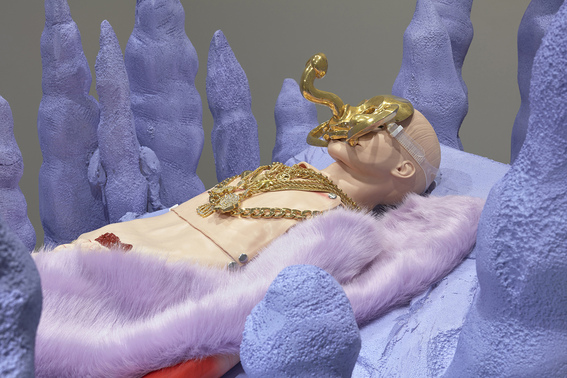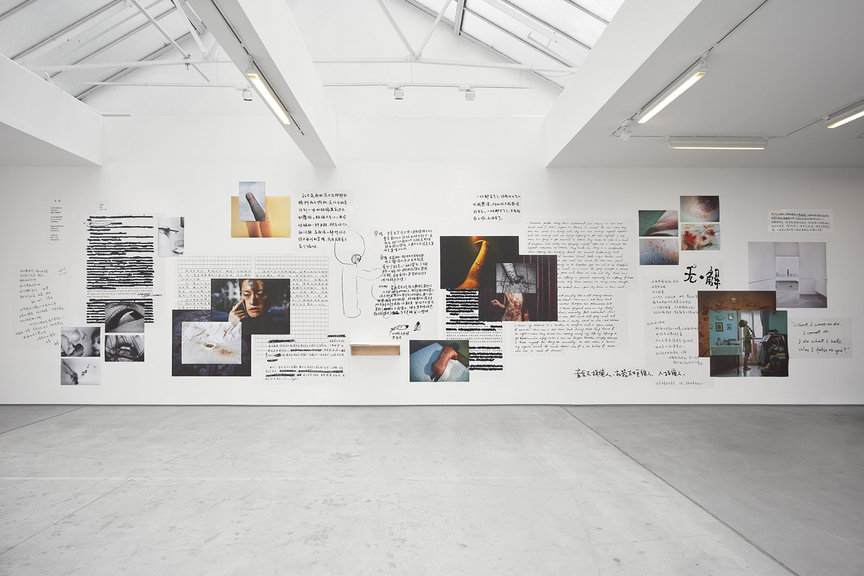-
From Current Issue
-
- Editor’s Letter Fire in the Heart
- Reviews I Gusti Ayu Kadek Murniasih
- Reviews 11th Seoul Mediacity Biennale: “One Escape at a Time”
- Dispatch Networked China
- One on One Monira Al Qadiri on Yukio Mishima
- Essays The rise of independent art spaces in pandemic-era Shanghai
- Features Tuan Andrew Nguyen
- Table of Contents
- Web Exclusives
- Archive
- Subscribe

R
E
V N
E
X
T
Installation view of LU YANG, Power of Will – Final Shooting, 2016, in “Zhongguo 2185” at Sadie Coles HQ, London, 2017. Copyright the artist. Photo by Robert Glowacki. Courtesy the artist and Sadie Coles HQ.
For “Zhongguo 2185” at Sadie Coles HQ in London, curator Victor Wang brought together ten Chinese artists born after 1970 for a presentation that looked to the future. The show’s theme was rooted in the ideas of science fiction author Liu Cixin, whose 1989 novel Zhongguo 2185, in which six computer-resurrected brains, including that of Mao Zedong, threaten a future utopia, lends its title to the show. The works succeeded in conveying the ambience of Liu’s writing, which carries a mix of nostalgia and futurism, transitions of scale, and where characters are continuously haunted by past traumas.
Tianzhuo Chen’s work spearheaded the presentation, and carries the strongest reference to Liu’s narrative in the sculpture Scapegoat 01 (2015), which presents a dissected corpse laid out on a dais, or a lifeless Frankenstein monster waiting to be reanimated. In Liu’s fiction, technology makes possible acts of resurrection and matter manipulation, endowing characters with a quasi-priestly status, with secret cults forming as a result. Chen’s work captures this esotericism with the placement of ritualistic items around the body and by covering its face with a mask, which also features in the artist’s video Ishvara (2016) shown beside Scapegoat 01. In the documented performance, a cast of fantastical personalities perform a ritual that climaxes with two fang-toothed figures writhing in a possessed state—one can imagine they are exorcizing Liu’s historical demons.
The artists in “Zhongguo 2185” share the contemporary dystopian pessimism that features in Liu’s writing. This is a welcome shift in how Chinese artists have been presented in the United Kingdom in the last decade, when a narrative of monumental, utopian consumerism has dominated. Chen Zhe’s wall piece of text and photographs Bees & The Bearable (2007–12) is an extraordinary and intimate portrait of lives experiencing extreme breakdown. The poignant expressions of youthful angst and loneliness found in the handwritten notes are familiar, and the imagery of self-harm will connect Chen’s work with the canon of self-revelatory art practices of many others. Chen’s observation of the hopelessness of an emerging generation is at odds with the aggressive utopianism projected onto China by some parties abroad. Here, the artist and her collaborators make an explicit and honest confession of their mental states in ways that still seem taboo-busting, despite the prevalence of voyeurism and surveillance culture at home and abroad.
Xu Qu alludes to the absorption of surveillance architecture by an authoritarian state in the sculpture Occupation II (2017), which hung in front of Chen Zhe’s installation. Obsolete cameras are strung together like a giant set of prayer beads, turning the technology used by the state into a quasi-religious object. In his novel The Three-Body Problem (2006), Liu Cixin describes what happens to the story’s main character after encountering an advanced extraterrestrial nanotechnology that facilitates omniscience. The devastating revelation of this alien Big Brother is tempered by the resilience of the character Ye Wenjie during the Cultural Revolution. Xu’s work equates authoritarian surveillance with a kind of meditative state; the real transformation of the interrogated subject takes place at a psychological level. The artist’s process of collecting redundant cameras illustrates that most surveillance efforts are purposeless.
Several works play with extremes of scale, reflecting another aspect of Liu Cixin’s writing, in which there are spectacular transitions between nanotechnology and megastructures, and compressions of space and time. Nabuqi and Yu Ji both showed intriguing miniaturized architectures that relay the artists’ ambivalence toward the idea of Chinese Metropolises being stages set for utopia. Paintings by Lu Pingyuan and Tang Dixin, along with Sun Xun’s epic, 16-meter-long drawing on hand-made bark paper, One Hundred Years of Solitude (2017), show us individuals lost in this accelerated future history. The show’s capstone is Lu Yang’s Power of Will – Final Shooting (2016), a massive balloon replica of the artist’s head and hair. That it was trapped in the gallery and unable to take flight was a dispiriting vision of a post-human future.
“Zhongguo 2185” is on view at Sadie Coles HQ, London, until November 4, 2017.
To read more of ArtAsiaPacific’s articles, visit our Digital Library.








